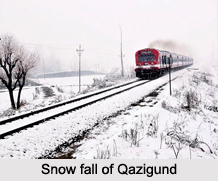 Qazigund is known as the Gate Way of Kashmir. It is a town and a notified area committee in Kulgam district in the Indian state of Jammu and Kashmir. As Qazigund is the gateway of Jammu and Kashmir, one can find many posh and cheap hotels to stay there.
Qazigund is known as the Gate Way of Kashmir. It is a town and a notified area committee in Kulgam district in the Indian state of Jammu and Kashmir. As Qazigund is the gateway of Jammu and Kashmir, one can find many posh and cheap hotels to stay there.
Location of Qazigund
Qazigund is located at 33.59 degree North to 75.16 degree East. It has an average elevation of 1670 metres (5478 feet) above mean sea level.
Demography of Qazigund
Qazigund had a population of 9871. The males constitute 55% of the population and females 45%. Qazigund has an average literacy rate of 70.21%, higher than the national average of 67.16%, male literacy is 79.82%, and female literacy is 58.27%. In Qazigund, 20.67% of the population is under 6 years of age.
Culture of Qazigund
Qazigund has always been known for religious tolerances. Amongst Hindus, Sh Pushker Nath Raina, of Chowgam, was a highly respected person and a great thinker and philosopher, who ensured communal harmony all the time. Muslims, Hindus and Sikhs reside peacefully in Qazigund from centuries.
Tourism in Qazigund
Qazigund is surrounded by springs known as Nags in local language. Verinag source of river Jehlum is only 10 km from Qazigund. Panzath Nag is just 3 km from Qazigund and famous Kound Nag is around 7-10 km from Qazigund.
Banihal Railway Tunnel
Banihal railway tunnel or Pir Panjal Railway Tunnel is an 11 km long railway tunnel under the Pir Panjal Mountains to connect Qazigund railway station to Banihal railway station. It was bored in late 2011 and became operational by 26th December 2012. It is India`s longest and Asia`s third longest railway tunnel and reduced the distance between Quazigund and Banihal to only 11 kilometres.
Visiting Information
Qazigund is connected to Anantnag and Srinagar by road and railway. There is a train service from Qazigund to Srinagar four times a day, and is connected to Kulgam by road. Qazigund is connected to Jammu and rest of India through NH 1A that passes through Jawahar Tunnel of Pir Panjal mountain.
Related Articles:
Indian Railways
Banihal, Ramban District, Jammu and Kashmir
Ramban, Ramban District, Jammu and Kashmir
Pir Panjal Range
Kashmir Himalaya, Indian Himalayan Region
Jammu and Kashmir



















